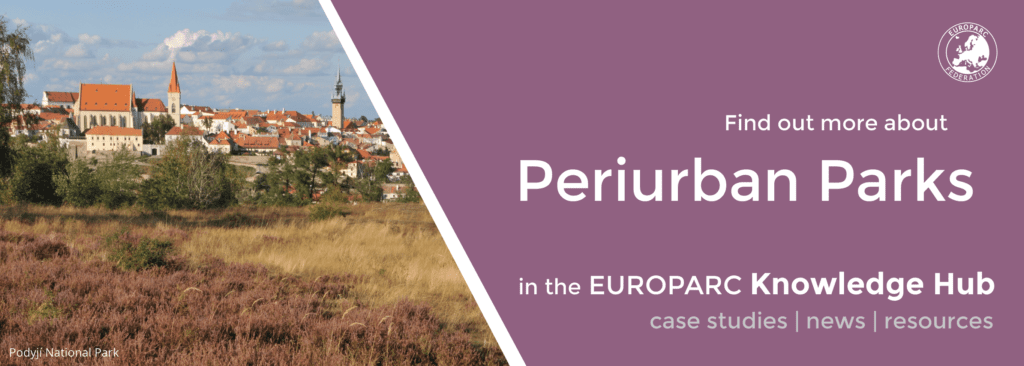Updates in the framework of the N2000 biogeographical process – marine conservation
View of a coast of the Orkney Islands, Scotland - 20/10/2008. Photo by Laurent Chamussy
Last March 2nd, EUROPARC Federation attended the European Commission Sub-Expert Group On Marine Issues, known as Marine Expert Group – MEG, a sub-group under the Birds and Habitats Directives created in 2003 to support the implementation of the Directives in the marine environment.
The meeting was facilitated by Vedran Nikolic – Policy Coordinator, Nature Conservation, Directorate General for Environment, and attended by aprox. 75 participants and representatives from national authorities, public agencies, Marine Protected Areas management authorities, fisheries representatives and NGOs from all over Europe. The gathering aimed to provide an update on the latest developments regarding the implementation of the Biodiversity Strategy in the marine environment and the recently published Marine Action Plan.
Like in previous occasions, the Commission collected comments from the participants in relation to these documents, possible considerations on its implementation arising at national, regional or local level and tackle any other business concerning the political framework for the conservation on the marine environment and its application.
Pledges on Conservation and Protected Area targets
After the release of the Biodiversity Strategy 2030, the European Commission called to Member States to prepare and report detailed plans, known as pledges, on the actions that will be implemented for the conservation and restoration of marine habitats and species at national level by the end of February 2023.
The pledges reporting was divided into two main components:
- Pledges for Conservation Status Improvement targets and;
- Pledges for Protected Area targets.
The structure and contents of the pledges was explained during the MEG meeting, and it includes:
- Protected Areas current extent per biogeographical region/ marine region and what is expected to be achieved by 2030 – including detailed explanations on the proceeding through which new Protected Areas have been proposed or designated and the inclusion of information regarding Natura 2000 that contribute to the 10% strict protection.
- Other Area-based Conservation Measures (OECMs) current extent per biogeographical region/ marine region and what is expected to be achieved by 2030 – despite of the existing criteria set by the Convention on Biological Diversity (CBD) to design and clarify what OECMs are, these protection figures have proved to be quite controversary in previous discussions due to the uncertainties these definition and its implementation. However, in the meeting
it was highlighted that their contribution to the Biodiversity Strategy targets is very important and therefore must be included in the pledge reporting process.
- Explanation on the coherence of the network – detailed information on the criteria established for assessing the coherence of MPA networks was provided as follows:
- Representativity – ensuring that the range of marine habitats and species for which MPAs are considered appropriate are protected within MPAs;
- Replication – ensuring that enough occurrences of a given feature are protected within MPAs and ensuring replication reflects what is known about a given feature´s biogeographic range;
- Connectivity – ensuring individual MPAs are well connected in terms of facilitating the exchange of species and their propagules;
- Adequacy – ensuring individual MPAs are of a specific minimum size, especially in relation to pressure of human activities and the needs of specific habitats and species;
- Management – ensuring that effective management plans are put in place, with responsibility assigned for delivery.
Status of Pledges
A detailed revision of the reporting status of these pledges was also presented. As of March 2nd 2023, only Luxemburg and Spain have submitted their pledges on both Conservation Status and Protected Areas.
Among the remaining 25 countries, half of them is expected to be submitted in the following two months. The reasons for the delay in both pledges are mainly limited data available or capacity, length of governmental endorsement process, length of stakeholder engagement processes and obstacles in regards of the coordination between regions. All these reasons, especially the one concerning stakeholder engagement processes, were deemed by the commission as very challenging and that sufficient time should be taken to address them.
Some other difficulties found were concerning the lack of funds to carry out the necessary actions to design the necessary conservation and restoration actions and produce the pledges on time. Since the EU did not provide specific funding for the implementation of the Biodiversity Strategy, these actions should often be articulated through projects that require also time and effort from the hand of the organisations to achieve the necessary results.
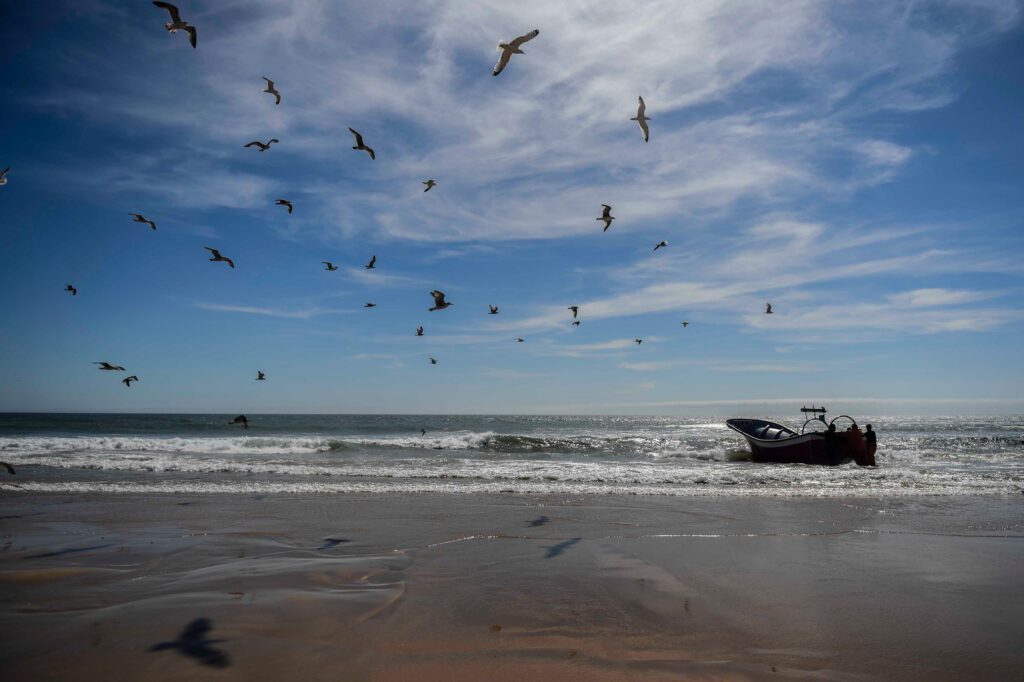
Fishermen pulling their fishing boat to the sea as seagulls fly over, Costa de Caparica, Portugal – 27/05/2019. Photo by Patricia De Melo Moreira
Pledges assessment process
After its submission, the pledges will be reviewed and assessed in order to measure progress towards the achievement of the numerical targets stated in the Biodiversity Strategy and provide initial feedback on network coherence.
The organisation in charge of receiving and managing the pledges is the European Environmental Agency, and during the meeting a representative from the EEA – Elena Osipova – presented a quick revision of the pledges assessment process and some considerations for its reporting.
On the one hand, it is noteworthy that Member States ‘commitments to the Biodiversity Strategy conservation objectives are voluntary and therefore the assessment of the pledges are not an evaluation of compliance. The aim of the assessment is to support Member States in designing and implementing their conservation strategies and to provide them with relevant topics of discussion at events and seminars organised in the framework of the biogeographical process.
On the other hand, as it was stressed during the meeting, the pledges reporting and assessment is a new process for everyone involved, and that “methodologies will develop as the picture unfolds”. Therefore, it is an open process that will be subject to revision and updates.
Additionally, the Commission reminded that the pledges assessment will be carried out during the Biogeographical Seminars that Member States are invited to organise, according to the following biogeographical regions:
- the Baltic Sea region
- Atlantic and Macaronesian regions
- Mediterranean and Black Sea regions
As of today, the call for events to be held during spring 2023 is already closed, but a second call for those events that will take place during the summer is open until April 17th. More information on the organisation of the events can be found here.
The challenges of designing coherent MPA networks
New Protected Areas will need to be designated based on smart and efficient Marine Spatial Planning in order to achieve a coherent network and based on the criteria explained above.
However, the existing species and habitats maps of Europe have proved to not to be sufficient for establishing a baseline with enough and detailed information upon which the planification of a coherent network of protected areas should be carried out. In example, some sub-habitats or habitat patches can be very important to protect but are not mapped due to their small size or distribution. Likewise, there is not enough information on habitats that sustain natural processes on which key species rely, such as reproduction and nursery areas.
For this reason, it is important to drive sufficient efforts into actions that allow us to get a better understanding of where key species, habitats and process are located in our seas in order to protected them. In this line of action, after the pledges status revision, an initiative that aims to contribute to the marine species and habitats mapping and MPAs network design was presented by Mark J. Costello – Nord University, Norway: the Horizon MPA Europe project.
This project, which will conclude in 2026, aims to carry out a wide assessment and mapping of areas that comprehend high biodiversity levels, not just species, and blue carbon storage areas in Europe, and create a model of potential MPAs. During the presentation, a model of the optimal MPA network at global scale that included 30% of the ocean, 70% of the species and 90% of biomes and habitats, was presented.
The new Marine Action Plan to conserve fisheries resources and protect marine ecosystems
The MEG meeting concluded with an overview of the recently published Action Plan: Protecting and restoring marine ecosystems for sustainable and resilient fisheries, which together with three other measures conforms the package that the European Union is putting in place to improve the sustainability and resilience of the EU’s fisheries and aquaculture sector.
This action plan builds over existing legislation and tries to fill some gaps between policies, mainly between the fisheries and environmental world, and to support the implementation of the CFP. The plan has 4 main lines of action:
- Improve gear selectivity and address bycatch of sensitive species;
- Protect the seabed;
- Facilitate knowledge exchange and transition;
- Improve Governance.
A detailed article on the Marine Action Plan can be found in our News section and more information will be available in our website – EU Marine Policies section, soon.
You can also access the whole Communication from the Commission: EU Action Plan: Protecting and restoring marine ecosystems for sustainable and resilient fisheries at the EC’s website here.
New EU Action Plan to restore marine ecosystems for sustainable and resilient fisheries
IJmuiden, 25-26 March 2002. A fishing boat leaves the port of IJmuiden to go fishing in the North Sea. The nets are hauled in to recover the catch. Photo by Jan van de Vel - European Communities, 2002.
Yesterday March 21st, the European Commission published the Action Plan: Protecting and restoring marine ecosystems for sustainable and resilient fisheries as part of the set of measures aiming to improve the sustainability and resilience of the EU´s fisheries and aquaculture sector.
Towards lower impact fisheries and sustainable stocks
This action plan has been designed to reinforce the support provided by the Common Fisheries Policy´s to guarantee that healthy fish stocks and rich biodiversity levels are sustained in time in our oceans. The main actions presented aim to reduce the negative impacts of fishing activities on the marine ecosystems, especially those related to by-catch of sensitive species and its consequent effects on the marine food webs, and increase the selectivity of fishing gears.
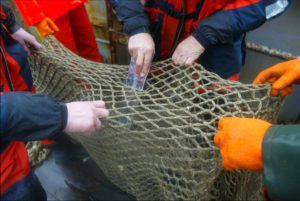
IJmuiden, 25-26 March 2002.
Coast Guards and Official Control Inspectors set out to control fishing vessels in the North Sea.
The inspectors control the net the fishermen use. Photo by Jan van de Vel – European Communities, 2002.
Additionally, the action plan will contribute to the objectives of the recently agreed Kunming-Montréal biodiversity agreement and in delivering the EU Biodiversity 2030´s environmental targets so the EC calls all Member States to put into place adequate fisheries conservation measures to effectively manage Marine Protected Areas. These measures should embrace actions to protect fish spawning and nursery areas, reduce fish mortality rates and restore core areas for sensitive species and habitats.
On another line, the action plan aims to decrease seabed disturbances originated by fishing apparels in MPAs and the Commission calls Member States to progressively reduce mobile bottom fishing in all MPAs by 2030, as well as to forbid it in newly established MPAs. It is noteworthy that the seabed habitats comprised within MPAs play a pivotal role in the protection of marine biodiversity, as they often constitute biodiversity hotspots, and act as blue carbon reservoirs that are very needed in tackling climate change impacts.
Other measures to improve EU’s fisheries and the aquaculture sector
Together with the Action Plan: Protecting and restoring marine ecosystems for sustainable and resilient fisheries three other elements that conform the package of measures presented by the European Commission are been presented:
- a Communication on the Energy Transition of the EU Fisheries and Aquaculture sector;
- a Communication on the common fisheries policy today and tomorrowand
- a Report on the Common Market Organisation for fishery and aquaculture products.
These other measures aim to promote the use of cleaner energy sources, such as renewable and low-carbon power sources, and reduce the dependency of the fishing sector on fossil fuels, making it less vulnerable to increases in energy prices. The main goal of this energy transition is to reach climate neutrality by 2050, as it is reflected in the European Green Deal. In this context, an Energy Transition Partnership for EU Fisheries and Aquaculture it is being proposed in order to bring together all stakeholders to collectively address the challenges this transition entails.
Additionally, the Commission proposes the creation of a ‘Pact for Fisheries and Oceans”. Since the CFP constitutes the main legal framework to address the challenges that EU fisheries and the seas and, as of today, several obstacles to achieve its full implementation remain in place, this pact will bring together all stakeholders and the Commission in order to tackle them. The pact will allow to open a dialogue between the parts, build common understanding of the objectives to be achieved and help adapt the CFP where necessary.
Much of our economy depends on nature. Fisheries are quite possibly the sector where this link is most direct. Europe’s marine ecosystems and the fish, shellfish, algae, and plants that are part of them are crucial to the economic viability of fisheries. With these proposals we aim to build a sustainable relationship with our seas. The European Commission will work with local fishing communities, the aquaculture and fisheries sector and help them adopt sustainable practices, from reducing energy usage to using more selective fishing gear. As part of efforts to restore and protect nature, we also ask Member States to phase out bottom trawling in fragile areas. When we ensure the sustainability of fisheries we invest in the resilience and future of the sector and its workers. Working together, we can find the right balance and establish healthy marine ecosystems all over Europe -Frans Timmermans, Executive Vice-President for the European Green Deal – 21/02/2023
Resources of interest
For a quick overview on the Actions for sustainable and resilient fisheries, aquaculture and marine ecosystems, visit this Factsheet.
For detailed information on the four elements that conform the Commision´s package of measures to improve the sustainability and resilience of the EU’s fisheries and aquaculture sector, please visit the documents below:
EU Action Plan: Protecting and restoring marine ecosystems for sustainable and resilient fisheries
Communication on the common fisheries policy today and tomorrow
Report on the results of Common Market Organisation for fishery and aquaculture products
Takeaways from IMPAC5 – the 5th International Marine Protected Areas Congress, Canada.
Syexwáliya Ann Whonnock, Squamish Nation elected counsilor - IMPAC5. Photo by IISD/ENB | Anastasia Rodopoulou.
The congress embraced relevant topics such as communities, youth and indigenous peoples´ involvement, sustainable financing for MPAs, sustainable fisheries and several aspects on MPA governance and management.
From February 3rd to the 9th, the 5th International Marine Protected Areas Congress (IMPAC5) opened its doors in Vancouver, Canada. This global forum aims to engage ocean conservation professionals, youth delegates, Indigenous Peoples, authority representatives and other stakeholders from all over the world to exchange knowledge, experiences and best practices to strengthen the conservation of marine biodiversity and the protection of the ocean.
Hosted in the traditional territories of the First Nations’ Squamish, Musqueam, and Tsleil-Waututh Nations, the congress had a strong presence of First Nations and Inuit representatives, who reminded us all that Canada is an ocean nation, with the longest coastline in the world and that protecting of marine ecosystems is key for the nation’s survival. During the opening and in this same line of thought, it was emphasized the vital role that oceans play in people’s lives, both for the services they provide to our society (1) and the deep connection that exists between the ocean and Canada’s culture and economy (2).
The opening ceremony also highlighted that the congress is an official activity of the UN Decade of Ocean Science for Sustainable Development and a contributing act for the implementation of the recently adopted Kunming-Montreal Global Biodiversity Framework.
The Kunming-Montreal Global Biodiversity Framework
The recently agreed upon Kunming-Montreal Global Biodiversity Framework is an important step for global conservation. This framework aims to halt and reverse biodiversity loss and covers marine areas within national jurisdiction and, in the congress, it was recognised as “the most important universal agreement we have”, while it was underscored that there cannot be a healthy planet without a healthy Ocean, and that its health is in decline (3).
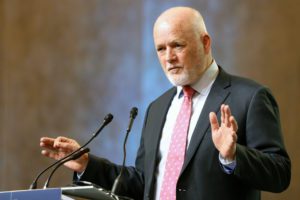
Peter Thomson, UN Secretary-General’s Special Envoy for the Ocean – IMPAC5. Photo by IISD/ENB | Anastasia Rodopoulou.
One particular target includes the commitment to protect 30% of the oceans by 2030 (also known as 30×30). However, this is an incredible challenge, as it implies expanding to almost triple the current Marine Protected Areas (MPAs) in the next seven years (4).
In this line, a specific discussion took place on the efficacy of a 30% area target based on a case study on MPAs in the German North Sea, underlining that each MPA is subject to different stressors and therefore requires specific management solutions (5). However, a reminder of our existing lack of knowledge and understanding of extense areas of the oceans such as the high seas and the deep seas, and the necessity to create MPAs on these areas and around the Antarctic, was also presented together with a call to think beyond the 30×30, as protecting 30% of the planet is not going to solve all the world’s problems (6).
Community involvement – Empowering communities to lead the way

Sylvia Earle, Founder and Co-Chair, Mission Blue 1 – IMPAC5. Photo by IISD/ENB | Anastasia Rodopoulou.
Local communities, specifically indigenous communities as the hosts of the land on which the congress took place, were undoubtfully another key topic during the congress. Both local communities and small-scale fisheries have a key role in leading the way on environmental stewardship and marine conservation (7) and it is crucial to incorporate their perspectives and knowledge (8).
The benefits of empowering communities to participate and collaborate in the conservation of resources and livelihoods, as well as to achieve a sustainable management, were also presented through examples from Myanmar (9) and Tanzania (10). Other interesting cases about community led initiatives were presented: A community led coral conservation and restoration activities that include the certification of community coral gardeners in San Andrés, Colombia (11); A monitoring and reporting framework on a marine reserve developed in cooperation with indigenous people in New Zealand (12); An ongoing process to develop a community-based MPA in this southern Chilean archipelago (13).
Sustainable Finances and Sustainable Tourism in MPAs
The integration of science and community-based approaches were also identified as a solution to improve the management and financial sustainability of the MPAs (14). Other examples of blue finance solutions were presented from Onnason, Okinawa, on a mozuku seaweed farming and coral plantation (15).
Sustainable Tourism was also integrated in the conversations. From a financial point of view, an example on the development of a business model based on raising revenue from sustainable tourism in order to support the budget of the Turneffe Atoll Marine Reserve was presented (16). As a counterpart, the efforts undertook to limit the negative to regulate diving tourism in Karimunjawa National Park in the Java Seas, Indonesia, were explained and reminded the participants the negative impacts that tourism activities can pose to marine ecosystems (17).
Challenges in MPA Management and Governance
Some interesting reflections on MPA management and its challenges were brought to the discussion. It is noteworthy to mention the presentations submitted about Gwaii Haanas National Park in Canada, covering an overview of its history over the last 30 years and its main challenges and solutions. In this regard, some conclusions on research studies on measuring co-development of governance indicators to support the implementation of a landsea-people plan in this Park were exposed (18).
Other factors underpinning MPA management were identified as social, economic and ecological elements, as explained in a case study on the management of San Antonio MPA (19). Likewise, , social acceptance of MPAs was identified as another barrier in its implementation and, based on the research outcomes on a generic MPA model, it was concluded that many times the opposition to MPAs is not against conservation, but rather the design and implementation model used (20).
On the other hand, Transboundary Cooperation was also present in the discussion with an example on Transboundary Protected Areas management in the Eastern Tropical Pacific in which the importance of enabling the harmonization of different legal, political, and cultural systems and the necessity to develop of a stronger legal framework for “ecological connectivity” were underscored (21).
Another case study in this line was brought on the work of a civil society network for the conservation of the Patagonian Sea, the challenges they face, and how views should be standardized between decision-makers of different countries to reach effective protection when management extends beyond country boundaries (22).
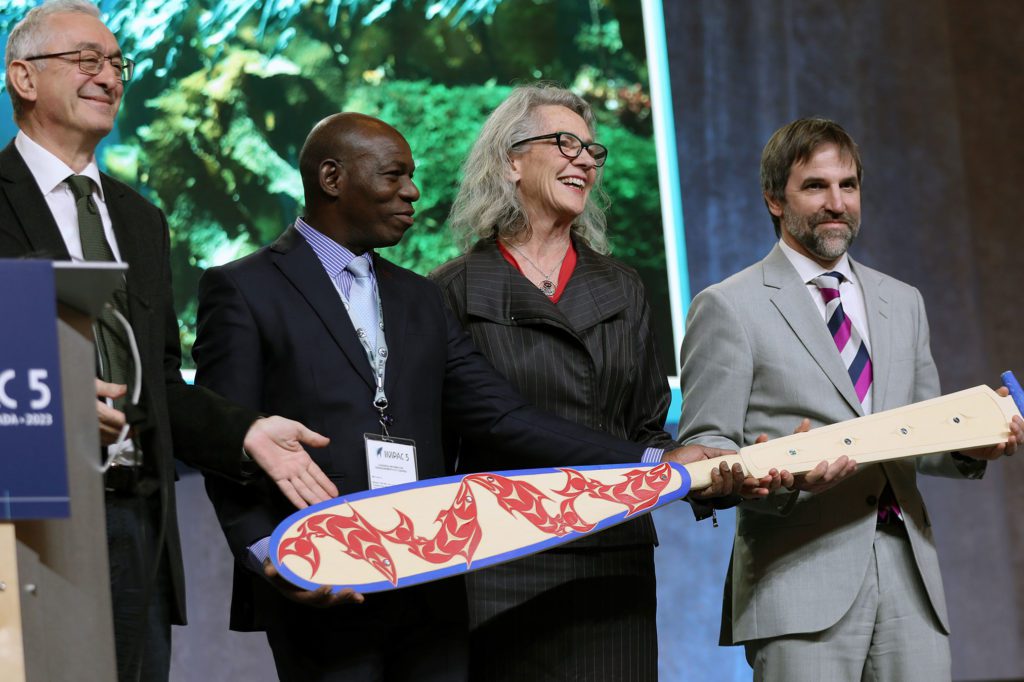
L-R: Bruno Oberle, Director-General, International Union for Conservation of Nature, Mamadou Sidibé, Director of Community Marine Protected Areas, Senegal, Joyce Murray, Minister of Fisheries, Oceans, and Canadian Coast Guard, and Steven Guilbeault, Minister of Environment and Climate Change, Canada – IMPAC5. Photo by IISD/ENB | Anastasia Rodopoulou.
The importance of Other Effective area-based Conservation Measures (OECMs)
As it was underscored during the congress, OECMs present a unique opportunity for stakeholders to get involved in conservation measures. In this regard a case study on the Baltic Sea in relation to the role of the Regional Sea Conventions, highlighting the need of a cross-sectorial approach to interpret the OECM criteria, was presented (23).
Additionally, reflections on the need to bring the socio-economic sectors into the conservation discussion, to clarify to all stakeholders the differences between MPAs and OECMs (24), the necessity of a clearer understanding of the identification process of OECMs (25) and the facilitating role that NGOs can have were also made (26).
Youth involvement

Sean Russell, IMPAC5 Young Professionals Committee – IMPAC5. Photo by IISD/ENB | Anastasia Rodopoulou.
Youth and their involvement in marine conservation was also one of the topics that stood out during the conference and an IMPAC5 Youth Call to Action was presented during the congress, advocating for a set of youth-determined priorities (27).
Furthermore, the work carried out by Connect to Protect initiative which aims to build a digital community and encourage youth leaders to join the GenSea network to collaborate and nurture a community of youth ocean advocates was exposed (28). Panellists were also invited to reflect on several questions encompassing empowering youth in organizations and hiring them (29).
Further mentions to youth involvement were done in regards of the importance of creating opportunities for children in the school system (30), and of facilitating ways young people can contribute in culturally relevant ways (31).
If you are interested to learn more, we suggest reading the Earth Negotiations Bulletin and listening to the Protecting Blue Nature podcast series.
References to the speakers mentioned in this article can be found below:
(1) Joyce Murray, Minister of Fisheries, Oceans, and the Canadian Coast Guard, Canada.
(2) Amandeep Singh, British Columbia Parliamentary Secretary for Environment, Canada.
(3) Peter Thomson, UN Secretary-General’s Special Envoy for the Ocean, Fiji.
(4) Fanny Douvere from UNESCO’s World Heritage Marine Programme, France.
(5) Benne Wölfing, German Federal Agency for Nature Conservation, Germany.
(6) Sylvia Earle, ocean activists and National Geographic Explorer, United States.
(7) Anthony Charles, Saint Mary’s University, Canada.
(8) Nathalie Ban, University of Victoria, Canada.
(9) Zau Lunn, Flora and Fauna International (FFI), Myanmar.
(10) Tanguy Nicolas, MWAMBAO Coastal Community Network, Tanzania.
(11) Pablo Caldas, Conservation International, Colombia.
(12) Monique Ladds, New Zealand Department of Conservation, New Zealand.
(13) Enrique Higueras, Municipality of Las Guaitecas, Chile.
(14) Grace Gatapang, Blue Alliance Philippines, Philippines.
(15) Masanori Kobayashi from the Sasakawa Peace Foundation, Japan.
(16) Valdemar Andrade, Turneffe Atoll Sustainability Association, Belice.
(17) Rohmani Sulisyati, Karimunjawa National Park, Indonesia.
(18) Ella-Kari Muhl, University of Waterloo, Canada.
(19) Veronica Relano, University of British Columbia, Canada.
(20) Anne Cadoret, Aix-Marseille University, and Jean-Eudes Beuret, Rennes Agro Institute, France.
(21) Sarah Enright, University College Cork, Ireland.
(22) Catherine Dougnac, Wildlife Conservation Society, Chile.
(23) Jannica Haldin, HELCOM, Finland.
(24) Souha El Asmi, UNEP-MAP, Tunisia.
(25) Felipe Paredes, Ministry of Environment of Chile.
(26) Johnny Briggs, The Pew Charitable Trust, United Kingdom.
(27) Sean Russell, IMPAC5 Young Professionals Committee, Canada.
(28) Amelia Fortgang, EarthEcho, United States.
(29) Joseph Mcleod, Parks Canada, Canada.
(30) Jenn Stevens, Learning for Sustainable Futures, Canada.
(31) Joshua Komangapik, Students on Ice, Canada.
Exploring how Periurban Parks engage Urban Audiences
Guided visit at Sas Hegy nature reserve, on the edge of Budapest © Matthew Ross
Every year, the Alfred Toepfer Natural Heritage Scholarship supports the work of young conservationists in Protected Areas across Europe. Matthew Ross, learning and discovery ranger at the Peak District National Park, was one of the winners of the Scholarship in 2019. He travelled to Scotland and Hungary to learn more about how two Periurban Parks are approaching visitor management and nature education. The following article is written by Matthew. You can download his full report and a special toolkit at the end of the article.
The special case of Periurban Parks
Periurban Parks are a portal to nature connection for millions of people. However, the proximity to urban areas can also bring problems, with large numbers of visitors harming fragile ecosystems. Despite these challenges, there are also wonderful opportunities: we have a huge pool of people, on our doorstep, to inspire about nature! With our help, young people in these urban areas can learn to appreciate our beautiful landscapes and aspire to conserve them.
I work in the U.K’s Peak District National Park. This beautiful area is girdled by the urban areas of Manchester, Sheffield, Derby and Stoke; the threat of urban encroachment helped us become the U.K’s first national park. Seventy years later, it is these urban areas which provide a majority of the park’s visitors: millions every year!
My work involves trying to build a deeper connection between our visitors, especially young people, and the landscape. Our team provides outdoor learning experiences for schools, families, and community groups.
I have been very privileged to benefit from an Alfred Toepfer Natural Heritage scholarship, enabling me to travel to two other European national parks close to urban areas. My study aims were:
- To investigate issues caused by large visitor numbers, and how each park is trying to tackle these through engaging visitors.
- Observing engagement techniques used by parks, with a focus on inspiring young people.
- Finding out how national parks enable self-led visitors and remove barriers for less socially mobile groups.
The two parks I chose were:
- Duna-Ipoly Nemzeti Park, close to Hungary’s capital, Budapest.
- Loch Lomond & The Trossachs National Park, just outside Glasgow, Scotland.
Engaging visitors of the Parks
In each park I met staff, visited key interpretation sites and observed education sessions and events in action. It was very instructive to find parallels between our different national parks. Despite our different contexts, many of the issues we face are similar: antisocial behaviour, wildfires, traffic congestion and impacts from outdoor pursuits. These are made more severe by the volume of visitors from urban areas.
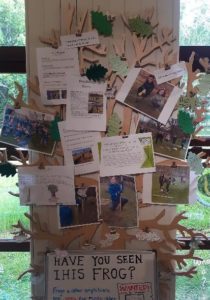
Display celebrating young people’s conservation, Loch Lomond © Matthew Ross
All three parks recognise that direct engagement offers a way, perhaps the best way, to communicate about these issues. Education sessions can provide direct care messages to audiences about environmental issues, helping to prevent problems and inspire positive action. Beyond the immediate benefits, all three parks are “playing the long game”, trying to inspire a love of nature that will filter through generations to forge a long-lasting stewardship of these landscapes.
Young people are particularly key to this. Engaging them and providing “Eureka!” moments that connect them with nature can encourage a lifetime of learning about, and caring for, our environment.
School visits, family events and activity trails all provide great ways of enabling this. Activities that allow young people to have their own, close-up connections with nature, such as pond dipping and ‘Bio-blitzes’ are especially valuable, and all three parks make this a key feature of their work. Nature play, with mud, sticks, and water is great, too!
There are also opportunities for promoting positive action through conservation. In Loch Lomond NP, junior rangers groups run in local schools, and I observed students removing invasive species from a local nature reserve. Photos and reflections from children taking part in conservation tasks are collected and displayed in the park’s visitor centre; this creates pride in their actions and helps to inspire other visitors.
Creating easy access to the Parks
Although the urban population are very closely situated to our national parks, many of them have barriers to visiting. Traditionally, our demographics have not reflected the diverse populations of our cities, and we must try to make our parks accessible to all. Loch Lomond & The Trossachs has pioneered an Educational Travel Grant, which helps enable economically disadvantaged schools and communities.
Creating ‘National Park champions’ within local communities can help inspire people to visit, and to do so responsibly. In the Peak District, we are developing community projects and an ‘Ambassador school’ scheme to this end.
Another way of engaging harder-to-reach-groups is meeting them in their local green spaces; the best connections with nature often begin at home, and sometimes these can be useful stepping stones to visiting bigger, wilder landscapes. Duna-Ipoly has pioneered a unique way of doing this: a mobile pond-dipping laboratory that travels around different areas, connecting children with nature (and the environmental issue of water quality) close to their schools.
Accessibility and engagement possibilities for independent visitors are important too. Interpretation boards, activity trails and online resources can all help with this. Duna-Ipoly even has a National Park app.
The above is just a very brief summary of the great work being done in these national parks. Learning from their innovative, inspiring staff has been very valuable, and now I hope to build on this to help my own team engage and innovate more effectively.
I feel very grateful for this opportunity, and would recommend any young people working in protected areas to apply for an Alfred Toepfer Natural Heritage Foundation scholarship.
If you’d like to learn more about some nature connection and engagement techniques, I have put together a small ‘toolkit’ of ideas that can be downloaded here.
